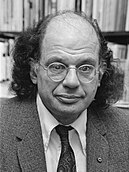
Back Beat-generasie Afrikaans جيل بيت Arabic Bit cərəyanı Azerbaijani Разбітае пакаленне Byelorussian Разьбітае пакаленьне BE-X-OLD Бийт поколение Bulgarian বিট প্রজন্ম Bengali/Bangla Generació beat Catalan بەرەی بیت CKB Beat generation Czech
The Beat Generation was a literary subculture movement started by a group of authors whose work explored and influenced American culture and politics in the post-World War II era.[1] The bulk of their work was published and popularized by Silent Generationers in the 1950s, better known as Beatniks. The central elements of Beat culture are the rejection of standard narrative values, making a spiritual quest, the exploration of American and Eastern religions, the rejection of economic materialism, explicit portrayals of the human condition, experimentation with psychedelic drugs, and sexual liberation and exploration.[2][3]
Allen Ginsberg's Howl (1956), William S. Burroughs' Naked Lunch (1959), and Jack Kerouac's On the Road (1957) are among the best-known examples of Beat literature.[4] Both Howl and Naked Lunch were the focus of obscenity trials that ultimately helped to liberalize publishing in the United States.[5][6] The members of the Beat Generation developed a reputation as new bohemian hedonists, who celebrated non-conformity and spontaneous creativity.
The core group of Beat Generation authors—Herbert Huncke, Ginsberg, Burroughs, Lucien Carr, and Kerouac—met in 1944 in and around the Columbia University campus in New York City. Later, in the mid-1950s, the central figures, except Burroughs and Carr, ended up together in San Francisco, where they met and became friends of figures associated with the San Francisco Renaissance.
In the 1950s, a Beatnik subculture formed around the literary movement, although this was often viewed critically by major authors of the Beat movement. In the 1960s, elements of the expanding Beat movement were incorporated into the hippie and larger counterculture movements. Neal Cassady, as the driver for Ken Kesey's bus Furthur, was the primary bridge between these two generations. Ginsberg's work also became an integral element of early 1960s hippie culture, in which he actively participated. The hippie culture was practiced primarily by older members of the following generation.
- ^ Evans, Mike, The Beats: from Kerouac to Kesey : an illustrated journey through the Beat Generation, Running Press, Introduction
- ^ The Beat Generation – Literature Periods & Movements.
- ^ Charters, Ann (2001). Beat Down to Your Soul: What was the Beat Generation?. Penguin Books. ISBN 0141001518.
- ^ Charters (1992) The Portable Beat Reader.
- ^ Ann Charters, introduction, to Beat Down to Your Soul, Penguin Books (2001) ISBN 978-0-14100-151-7 p. xix "[...] the conclusion of the obscenity trial in San Francisco against Lawrence Ferlinghetti for publishing Ginsberg's Howl and Other Poems [...] in which Judge Clayton W. Horn concluded for the defendant that 'Howl' had what he called 'redeeming social content.'", p. xxxiii "After the successful Howl trial, outspoken and subversive literary magazines sprung up like wild mushrooms throughout the United States."
- ^ Ted Morgan, Literary Outlaw, New York: Avon, 1988. p. 347, trade paper edition ISBN 0-380-70882-5: "The ruling on Naked Lunch in effect marked the end of literary censorship in the United States."
© MMXXIII Rich X Search. We shall prevail. All rights reserved. Rich X Search


